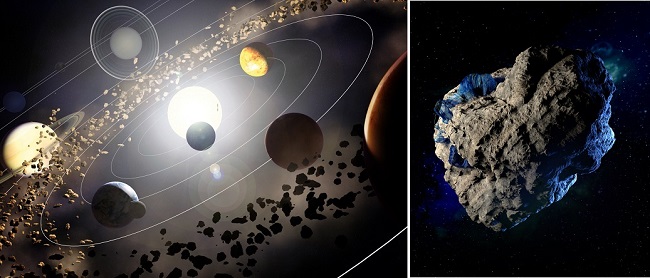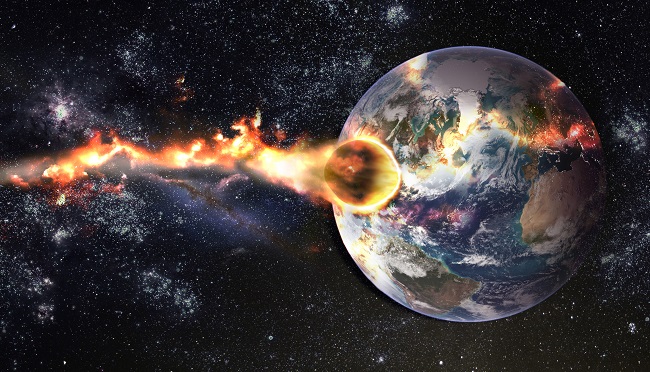Dec 17, 2025
Dec 17, 2025

Asteroids are rocky, airless remnants left over from the early formation of our solar system about 4.6 billion years ago. They are sometimes called minor planets. According to NASA, their current count is: 1,113,527.
Most of them are seen orbiting the Sun staying within the main asteroid belt that lies between Mars and Jupiter. Their size varies from 329 miles in diameter to 10 meters. Their combined total mass is estimated to be less than Earth’s Moon.
They are mostly irregular in shape. They revolve around Sun in elliptical orbits. They also rotate, sometimes quite erratically, tumbling as they rotate. Around 150 asteroids are known to have companion moons. There are also binary asteroids i.e., two rocky bodies of roughly equal size orbit each other.
They are broadly grouped into three categories:
The orbits of asteroids can be changed by the massive gravity of Jupiter. Even their close encounter with Mars or other objects can change their orbits. Such encounters can even knock asteroids out of asteroid-belt and hurl them into space in all directions across the orbits of the other planets. Such stray asteroids or their fragments were known in the past to slam into Earth and even other planets. Such hits played a major role in altering the geological history of the planets and the evolution of life on Earth.
Scientists are continuously monitoring the Earth-crossing asteroids whose paths intersect Earth’s orbit. They also monitor the near-Earth asteroids that are within 28 million miles of the Earth’s orbit, for they pose an impact danger.

The impact of asteroids on Earth is dependent on their size, speed, and angle at which they hit the Earth and their composition. If the asteroid hits on land, there would be a huge amount of dust thrown up into the atmosphere. If it hits a water body, there would be an increase in water vapour in the atmosphere resulting in rain and as a consequence, there could be landslides and mudslides. There might even be hurricanes and tsunamis due to increased kinetic energy. Hence, scientists constantly monitor them through radars and trace the asteroid’s orbit, rotation, size, shape, and metal concentration.
As a part of this monitoring and defense system against an Earth-threatening asteroid, if any, in the future, NASA has undertaken a mission to test check if intentionally crashing a spacecraft into an asteroid is an effective way to change its course. This planetary defense demonstration mission is named DART (Double Asteroid Redirection Test) and is to be managed by NASA’s Planetary Defense Coordination Office (PDCO).
To test check its capability, DART has chosen the binary asteroid system, Didymos as its target. In Greek, Didymos means ‘twin’, which explains the word, ‘double’ in the mission’s name. This Didymos system consists of two asteroids: the larger asteroid called, Didymos with a diameter of 780 meters, and the smaller moonlet asteroid named Dimorphos with a diameter of 160 meters. Dimorphos orbits the larger asteroid, Didymos. These two are at a distance of 1.18 km from each other. It takes 11 hours and 55 minutes for Dimorphos to orbit around the Didymos.
Didymos is considered as the most ideal candidate for the planetary defense experiment because as per the current predictions it is not on a path to collide with the Earth and therefore poses no actual threat to our planet. Secondly, it is considered easier to detect the deflection, if any, caused by the ‘Kinetic impact’ caused by crashing a spacecraft into it, in the local orbit of Dimorphos than a change of orbit of an asteroid orbiting the Sun.
Accordingly, NASA launched DART spacecraft in November 2021. After traveling 11 mn km from Earth, the 600 kg DART spacecraft slammed into the smaller asteroid, Dimorphos in the early hours of Tuesday, 27 September, 2022. After the blast, Professor Alan Fitzsimmons, an astrophysicist at Queen’s University Belfast said: “What amazed and delighted me was that everything worked so well”.
The collision and its impact are of course, yet to be assessed, for it takes longer time for the Licia Cube—the small satellite with a camera that had accompanied DART but separated from it 15 days before the collision—to transmit the images to Earth for analysis. Nevertheless, Lori Glaze, NASA planetary science director had this to say: “We are now embarking on a new era for humankind—an era in which we potentially have the ability to protect ourselves from a hazardous asteroid impact”.
On October 11, 2022, NASA announced that the mission had successfully changed the orbit of the asteroid Dimorphos. Using the data transmitted by the telescopes taken at the time of impact as well as in the subsequent weeks, NASA scientists calculated that the impact shortened Dimorphos’ orbit by 32 minutes.
However, to rightly understand the effect of collision, further analysis of the ‘ejecta’—the many tons of asteroidal rock displaced and launched into space by the impact—is needed. Nevertheless, as Nancy Chabot, the DART coordination lead from the Johns Hopkins Applied Physics Laboratory in Laurel, Maryland said, “DART has given us some fascinating data about both asteroid properties and the effectiveness of a 'kinetic impactor' as a planetary defense technology”.
But the irony is: We could build up the ability to protect ourselves from a hazardous impact from a celestial body but could hardly protect ourselves from an incoming man-made missile …. ...
Images (c) istock.com
12-Nov-2022
More by : Gollamudi Radha Krishna Murty